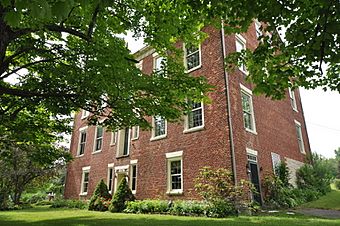David Mathews House facts for kids
Quick facts for kids |
|
|
David Mathews House
|
|
 |
|
| Location | VT 67/NY 67, Shaftsbury, Vermont and Hoosick, New York |
|---|---|
| Area | 2 acres (0.81 ha) |
| Built | 1800 |
| Architectural style | Federal |
| NRHP reference No. | 79000274 |
| Added to NRHP | September 10, 1979 |
The David Mathews House, also called the State Line House, is a really old house that sits right on the border between New York and Vermont. You can find it in Hoosick, New York and Shaftsbury, Vermont. This impressive brick house was built around 1800. It shows off the beautiful Federal architecture style. The house has many interesting stories connected to it, some of which might just be legends! It was added to the National Register of Historic Places in 1979 because of its importance.
Contents
What Does the Mathews House Look Like?
The Mathews House is located on the north side of Route 67. It's just west of State Line Road. The house is quite large, with three stories and five sections across its front. It's made of brick and has a sloped roof. The bricks are laid in a special pattern.
Special Features of the House
The house has fancy details like a full frieze (a decorative band) and a cornice (a molding at the top of a wall). These are part of the Doric order, a classic style of architecture. When it was first built, the main entrance faced north. But today, both the north and south sides have almost identical entrances. These doorways are set in round arches with fan-shaped windows above them. There are also tall, narrow windows on either side of the doors.
Inside, the house still has many of its original wooden parts. This includes special wood panels, decorative frames around the fireplaces, and molded frames around the doors.
Who Built the David Mathews House?
The David Mathews House was built around the year 1800. It was constructed by a man named David Mathews. He was a soldier who fought in the American Revolutionary War. Even though the house is in a quiet, rural area, it has many fancy features from the Federal period. This makes it quite unique for its time and place.
David Mathews's War Service
David Mathews served in the Continental Army, which was the main army of the American colonies during the Revolutionary War. However, some stories say he might have been a Loyalist. Loyalists were people who supported the British during the war.
Fun Stories About the House
One popular story about the house is probably not true, but it's fun to hear! The legend says that during the Revolutionary War, David Mathews stole about 3,000 gold coins. He supposedly took them from Friedrich Baum, a German soldier fighting for the British. The story claims Mathews buried these coins in the house's basement. But since the house was built after the war, this story is most likely just a myth.
The House as a Tavern
In the 1800s, the house was used as a tavern. A tavern was a place where people could eat, drink, and stay overnight. Sometimes, even legal meetings were held there. Because the house sits right on the state line, people used to tell a funny story. They said that a judge from New York couldn't convict someone if that person was standing on the Vermont side of the house!



